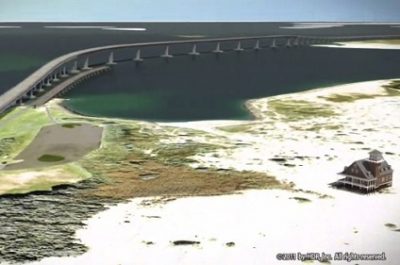
WASHINGTON, D.C. – President Donald Trump is pointing to the long-in-the-works Bonner Bridge Replacement Project in North Carolina as an example of how his administration’s cuts to environmental review requirements would hasten construction of major infrastructure projects.
Environmental advocates aren’t buying it.
Supporter Spotlight
A White House press release this week says inefficient environmental review processes have led to unnecessary delays, depriving communities of needed infrastructure projects, such as the state’s Bonner Bridge replacement in Dare County.
“No longer will we allow the infrastructure of our magnificent country to crumble and decay. While protecting the environment, we will build gleaming new roads, bridges, railways, waterways, tunnels, and highways,” Trump said in the statement.
The White House said federal agencies, including the Departments of the Interior, Agriculture, Commerce, Transportation, Energy and Homeland Security and the Environmental Protection Agency and Army Corps of Engineers, are signing a “One Federal Decision” memorandum of understanding, or MOU, for environmental reviews of major infrastructure projects.
Trump had called for the MOU in an executive order in August 2017. The MOU sets a two-year goal for each agency to complete all environmental reviews and authorization decisions for major infrastructure projects.
One lead federal agency is to be responsible for navigating each major infrastructure project through the entire federal environmental review and permitting process.
Supporter Spotlight
“Too many important infrastructure projects have been held up for years by the environmental review process,” according to the White House. The median environmental review for a complex highway project takes more than seven years, according to a 2014 Government Accountability Office report.
The White House said the environmental review and permitting for the Bonner Bridge project took more than 20 years, but environmental advocates say that’s not true.

Kym Hunter, staff attorney with the Southern Environmental Law Center, said citing the Bonner Bridge project as an example of the supposed need for streamlining environmental permitting shows the White House does not have its facts straight.
“In reality, the project was delayed because it is complicated. As designed by federal and state transportation agencies, the Bonner Bridge project is not just a bridge — it’s actually a 15-mile-long corridor on North Carolina’s Outer Banks, including many areas where the highway is falling into the Atlantic Ocean. Much of the early project delay was centered on local political concerns and funding shortfalls,” Hunter said.
She said that contrary to the White House statement, the Bonner Bridge project was an example of coordination between federal and state agencies as part of North Carolina’s Merger Team process. Throughout this process, agencies worked together to navigate local political concerns and funding limitations. Once the agencies reached consensus that they needed to start moving the highway away from the rapidly eroding shoreline, the process moved swiftly, Hunter said.
“There is nothing in the new MOU that would have expedited the Bonner Bridge project. If this is the best example the White House can come up with, we question the value of the proposal,” she said.
Hunter said law center attorneys were skeptical of the MOU. She noted that generally, projects get bogged down because of lack of resources and the Trump administration is doing nothing to address that issue.
“Without sufficient staff available in those agencies it’s hard to see projects moving forward any faster and still complying with relevant laws,” Hunter said. “We are concerned that some of the new proposed time frames could lead to rushed, illegal decision-making that doesn’t properly consider public input – particularly for a project as complicated as the Bonner Bridge.”







